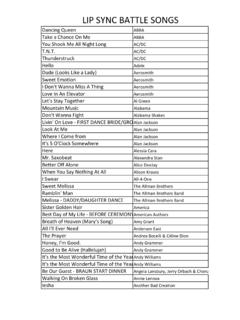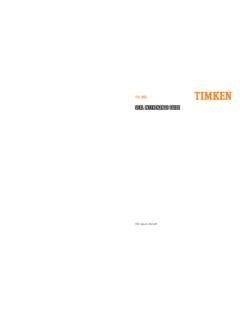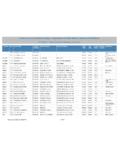Transcription of CAN/CSA-B651-95 Barrier-Free Design - …
1 CAN/CSA-B651-95 . Barrier-Free Design A National Standard of Canada Please Note: Refers to a formally approved revision dated June 1996. Copyright Canadian Standards Association (1) 1995. All rights reserved. No part of this publication may be reproduced in any form, in an electronic retrieval system or otherwise, without the prior permission of the publisher. Barrier-Free Design Contents Technical Committee on Barrier-Free Design Preface 1. Scope 2. Reference Publications 3. General Requirements Space Allowances Controls and Operating Mechanisms Floor Space Height Operation Illumination Ground and Floor Surfaces General Changes in Level Carpets Gratings Protruding Objects General Detectable Objects Attached to a Wall Freestanding Objects Clear Width Maintenance Headroom 4.
2 Circulation Accessible Routes, Paths, or Corridors Width Slope Doors Clear Opening Double-Leaf Doorways Manoeuvering Space at Doors Two Doors in Series Thresholds Door Hardware Door-Opening Force Power-Assisted Swinging Doors Ramps Running Slope and Length Cross Slope Width Landings Ramp Surfaces Outdoor Conditions Edge Protection September 1995 iii CAN/CSA-B651-95 . Ramp Handrails Curb Ramps Slope Width Surfaces Flared Sides Location at Pedestrian Crosswalks Islands Stairs Treads and Risers Nosings Detectable Warning Surfaces Stair Handrails Handrails Elevator Requirements Elevating Devices Areas of Refuge 5. Washroom Facilities Washroom Identification Toilet Stalls General Toilet Stall Doors Toilets General Toilet Location Toilet Flush Controls Toilet Grab Bars Lavatories General Faucets Lavatory Clearance Washroom Accessories General Mirrors Individual Washrooms General Equipment Bathtubs Floor Space Grab Bars Controls Shower Head Enclosures Shower Stalls Roll-in Shower Stalls Shower Stalls with Seat Shower Controls Shower Heads Shower Enclosures iv September 1995.
3 Barrier-Free Design Shower Floors Grab Bars Size and Spacing Structural Strength Safety Drinking Fountains Spouts Controls Floor Space 6. Communications Visual Alarms Public Telephones Protruding Parts Controls Cord Length Illumination Telephones for Persons in Wheelchairs Telephones for Use by Persons Who Are Deaf or Hard of Hearing Directional Signs Assistive Listening Systems Signage Character Proportion Contrast Illumination Tactile Characters or Symbols Symbol of Access Detectable Warning Surfaces 7. Parking Spaces and Passenger Loading Zones Circulation Routes Car Parking Spaces Van Parking Spaces Size Height Clearance Signs Designated Stalls Vertical Signs Symbol of Access Passenger Loading Zones Size and Access Vertical Clearance 8.
4 Seating Spaces Seating at Tables and Counters Clear Floor Space Clear Knee Space Viewing Positions 9. Recreation Facilities Benches Picnic Tables September 1995 v CAN/CSA-B651-95 . 10. Residential Units Basic Access Circulation Controls and Outlets Windows Visual Alarms Bathrooms Kitchens Laundry Facilities Outdoor Living Areas Complete Access General Elevating Devices Bathrooms Kitchens Miscellaneous Components Appendices A Slip Resistance of Floor Finishes B Anthropometrics C Elevator Requirements Index vi September 1995. Barrier-Free Design Technical Committee on Barrier-Free Design D. Henning Public Works and Government Chair Services Canada, Ottawa, Ontario A.
5 adams Barrier free Design Centre, Toronto, Ontario J. Beattie The Canadian Hearing Society, Toronto, Ontario S. Brink Canadian Centre for Management Development, Ottawa, Ontario Burningham Ontario Ministry of Housing, Toronto, Ontario Champagne Ottawa, Ontario J. Chu Bramalea Limited, Toronto, Ontario K. Dissette BOMA, Toronto, Ontario Dubiel American-Standard, Toronto, Ontario P. Falta Montr al, Qu bec Fern Parks Canada, Hull, Qu bec G. Laneuville Minist re du Travail du Qu bec, Montr al, Qu bec G. Maguire Stegweit and Maguire, Oakville, Ontario H. Monk EEPPD, Ottawa, Ontario T. Parker Canada Mortgage and Housing Corporation, Ottawa, Ontario September 1995 vii CAN/CSA-B651-95 .
6 L. Pringle City of Etobicoke, Etobicoke, Ontario J. Sanders The Canadian National Institute for the Blind, Ottawa, Ontario R. Thompson British Columbia Ministry of Municipal Affairs, Victoria, British Columbia J. Vasa School of Rehabilitation Therapy Kingston, Ontario Associate Members E. Boyd Canadian Paraplegic Association, Ottawa, Ontario B. Dion Betty Dion Enterprises, Ottawa, Ontario G. Grey Public Works and Government Services Canada, Ottawa, Ontario W. Hamilton The Canadian National Institute for the Blind, Ottawa, Ontario A. Prost Department of the Secretary of State, Ottawa, Ontario C. Stark Gloucester, Ontario C.
7 Zwierzchowski Public Works Canada, Ottawa, Ontario T. Bartoffy Canadian Standards Association, Administrator Etobicoke, Ontario viii September 1995. Barrier-Free Design Preface Individuals with disabilities shall be assured access to fundamental elements of daily life that are generally available in the community. Wherever possible the effects of an impairment or disability on an individual's life shall not be determined by environmental factors. (Principle 5 from the Prime Minister's Declaration on the Decade of Disabled Persons.). Thispublished is the second edition of CSA Standard CAN/CSA-B651, Barrier-Free Design . The first edition was in 1990.
8 The Standard contains requirements for making buildings and other facilities accessible to persons with a wide range of physical and sensory disabilities. It was developed to fulfill an expressed need for a national, technical standard covering a broad range of building and environmental facilities; a standard which could be referenced in whole or in part by a variety of adopting authorities. It must be understood by the user of this Standard that the requirements contained herein are minimum levels. This Standard does not have the force of law unless mandated by legislation or called up in the regulations of the authority having jurisdiction.
9 The user is advised to contact the local authority having jurisdiction in this area in order to determine to what extent this Standard is referenced. The requirements result from a consensus of the Committee members who represent a broad spectrum of interests. The members were encouraged and aided by the public comments received as a result of the wide distribution of a draft at the public comment stage. The format allows for commentary and illustrative information to be distinctly included but clearly separate from the requirements of the Standard. The document is organized by facility type such as circulation or washroom facilities.
10 Clause 10, Residential Units, can be used independently from the remainder of the Standard. Readers are encouraged to read the Scope section before using the document. CSA hereby recognizes the financial assistance provided by Public Works and Government Services Canada, whose support helped make the development of this Standard possible. The Handbook of Building Code, Section and the ANSI Standard were used as base references in developing the first edition of this Standard. This Standard was approved by the CSA Technical Committee on Barrier-Free Design under the jurisdiction of the Steering Committee on Public Safety. It has been approved as a National Standard of Canada by the Standards Council of Canada.



